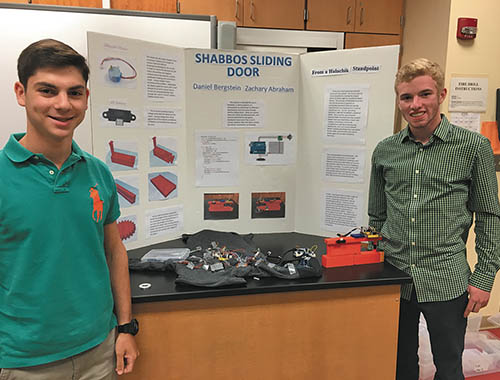
Frisch students in the elective engineering course, “Merging Halachic Judaism With Modern Life,” had a unique opportunity last week to present prototypes of their Shabbat-friendly innovations to Zomet Institute Director, Rav Binyamin Zimmerman. The course, taught by Mrs. Rifkie Silverman, Chair of Engineering and Computer Science at Frisch, is offered to students who have completed the engineering curriculum in 9th and 10th grades. The course explores the crossroads of halacha and modern technology in an effort to balance the two when necessary.
Silverman, an electrical engineer, has been teaching math and science at The Frisch School since 1999. Five years ago through CIJE, Center for Initiatives in Jewish Education, Frisch piloted an engineering program with 18 students. The program has since expanded to a four-year curriculum including engineering, computer science and robotics, with 90 students enrolled for the upcoming fall semester. While visiting the Zomet Institute in Israel, Mrs. Silverman met Rav Zimmerman and she immediately sought to create a program that would offer students an opportunity to explore the intersections of halacha and technology. Thus the senior elective engineering program was created.
Students spend the first half of the academic year learning Hilchot Shabbat with Rabbi Weinberger, a Talmud teacher, and explore how these laws manifest in modern life. The second half of the year is dedicated to creating a Shabbat-friendly innovation working within the framework of the halachot discussed. Students are required to build a working prototype of their invention in the lab. They have access to engineers at Zomet with whom they can consult on their projects via Skype or email.
Daniel Bergstein and Zachary Abraham presented their invention of a Shabbat-friendly electric sliding door. The system is intended for use in hospitals where patients are transported via wheelchair and must pass through motorized doors. Bergstein and Abraham presented their prototype before a roomful of students and faculty. They constructed a stepper motor in place of a DC motor and implemented an IR sensor to detect the presence of people. A typical electric sliding door is equipped with the capability to reverse direction and requires breaking a circuit. This is halachically not allowed. The stepper motor is permissible because it allows the change in rotation direction without breaking or completing any new circuits. Furthermore, there is always current in the motor, even when it is against the wall, to ensure no circuits are broken. The IR sensor is wired so that its voltage varies with the distance of the object. This concept does not defy any halachic prohibitions on Shabbos and is therefore acceptable when certain conditions exist. “The amount of thought and detail that goes into minimizing halachic transgression is extremely interesting,” Bergstein commented. Abraham describes the curriculum as “an eye-opening and unique experience. The ability to take what we learned in 9th and 10th grades and apply the halachic ideas to real-world issues is fascinating. We were able to meld our Judaic studies and our secular studies in a way that complemented one another.”
Students Adam Blank and Cassandra Scarpa presented their prototype of the Shabbat keyboard, which would allow a person who cannot speak to communicate on Shabbat. As with the halachic issues mentioned previously, on a normal keyboard, pressing a button breaks the circuit. The students created a button that just alters the circuit but does not break it. In reflecting on the past year’s studies, Blank explained, “this course offered in-depth knowledge on a practical basis. We dealt with real-life issues that we were able to approach and solve.” In most situations, these leniencies are afforded to those that have some sort of disability or disadvantage. Scarpa pointed out that “In certain circumstances you can violate rabbinic prohibition and one such circumstance is human dignity. In a situation like this, one can benefit from the Shabbat-friendly keyboard.”
In both prototypes presented, the students defended their models from a halachic standpoint thereby allowing an individual with a qualifying need to utilize the invention. These prototypes do not violate any d’Oraita (Biblical) laws.
Much of the research applied here was utilized in the conception of the electric wheelchair at Zomet. The Zomet Institute is dedicated to seamlessly merging halachic Judaism with modern life. The staff at Zomet, comprising rabbis, researchers and engineers, has devised practical halachic solutions for institutions, businesses and private citizens. Zomet’s engineers have developed and implemented technologies that enable products such as metal detectors, security jeeps, elevators, electric wheelchairs and coffee machines to be used on Shabbat.
Rav Zimmerman said he was impressed with the progress the students have made over the course of the year. “The ability to merge Torah knowledge and modern scientific inquiry is something very important. Jewish law is relevant in all ages and we have to figure out how to apply it to everyday life,” Rav Zimmerman commented. “We don’t always want to rely on non-Jews. In certain settings such as medical care facilities it is imperative to find ways for patients to function, while remaining within the boundaries of what is halachically permissible,” explained Rav Zimmerman.
Mrs. Silverman explained that she was ecstatic about this program and how it has grown. “To not have to make a choice between secular education and halacha is astounding,” she told The Jewish Link. “Hashem gave us the ability to study technology, and to open the door for our students at Frisch to view it as partnering with Hashem is extremely gratifying.”
By Andrea Nissel










